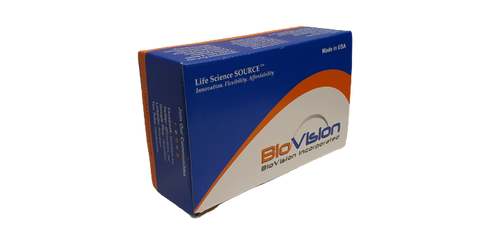Product Description
Glutaminase (EC 3.5.1.2) is a mitochondrial enzyme that hydrolyzes glutamine producing glutamate and ammonia. GLS is one of the two key enzymes including glutamine synthetase that are responsible for glutamine homeostasis. Since glutamine is a major metabolic substrate involved in gluconeogenesis, its homeostasis is tightly controlled. Glutaminase has tissue-specific roles in multiple organs, with the isoform GLS1 being expressed in kidneys and brain, and GLS2 being expressed in the liver. It is involved in maintenance of acid-base homeostasis by producing ammonia during renal acidosis in kidneys and regulation of glutamate, which acts as a neurotransmitter in the brain. BioVision’s recombinant GLS1 is catalytic domain of the original GLS1, which shows greater activity and excellent stability.
Biovision | P1656 | Human GLS1, Recombinant DataSheet
Biomolecule/Target :
Synonyms: Glutaminase, cKGA, catalytic domain of KGA, Glutaminase kidney isoform, mitochondrial, KGA, GLS1, GAC, GAM, KGA
Alternates names: Glutaminase, cKGA, catalytic domain of KGA, Glutaminase kidney isoform, mitochondrial, KGA, GLS1, GAC, GAM, KGA
Taglines: A mitochondrial enzyme that hydrolyzes glutamine producing glutamate and ammonia
NCBI Gene ID #:
NCBI Gene Symbol:
Gene Source: E Coli
Accession #: O94925
Recombinant: TRUE
Source:
Purity by SDS-PAGE: ≥ 95% by SDS-PAGE
Assay:
Purity:
Assay #2:
Endotoxin Level:
Activity (Specifications/test method):
Biological activity: Biological activity was performed using BioVision’s Glutaminase Activity Assay Kit (Colorimetric) (Cat# K2067-100).
Results:
Binding Capacity:
Unit Definition: One unit of GSL1 is defined as the amount of enzyme that produces 1 umol of glutamate per minute at 37 °C under the assay conditions.
Molecular Weight: 36.7 kDa
Concentration: Lot specific
Appearance: Colorless liquid
Physical form description: Liquid
Reconstitution Instructions:
Amino acid sequence: aa 221-533
Handling: Centrifuge the vial prior to opening.
Usage: For Research Use Only! Not to be used in humans
 Euro
Euro
 USD
USD
 British Pound
British Pound
 NULL
NULL








